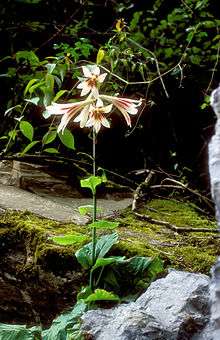Cardiocrinum
| giant lilies | |
|---|---|
 | |
| Cardiocrinum giganteum | |
| Scientific classification | |
| Kingdom: | Plantae |
| (unranked): | Angiosperms |
| (unranked): | Monocots |
| Order: | Liliales |
| Family: | Liliaceae |
| Subfamily: | Lilioideae |
| Tribe: | Lilieae |
| Genus: | Cardiocrinum (Endl.) Lindl. |
| Synonyms[1][2] | |
|
Lilium unranked Cardiocrinum Endl. | |
Cardiocrinum is a genus of bulbous plants of the lily family first described as a genus in 1846.[3] They are native to the Himalaya, China, the Russian Far East, and Japan.[4][5] The bulbs are usually formed at the soil surface. The preferred habitat is woodland. The plants tend to be monocarpic, dying after flowering.
They are closely related to Lilium and are generally called by the common name giant lilies. They differ from Lilium in some characteristics, most notably in the heart shaped leaves (hence the name, from the Greek kardio for heart, and krinum for lily).
The Himalayan species Cardiocrinum giganteum is the largest of any of the lily plants, growing up to 3.5 metres high.
- species[4]
- Cardiocrinum cathayanum (E.H.Wilson) Stearn - E + C China
- Cardiocrinum cordatum (Thunb.) Makino - Japan, Kuril Islands, Sakhalin
- Cardiocrinum giganteum (Wall.) Makino - Gansu, Guangdong, Guangxi, Guizhou, Henan, Hubei, Hunan, Shaanxi, Sichuan, Tibet, Yunnan, Bhutan, Assam, Myanmar, Nepal, Sikkim
References
- ↑ Endlicher, Stephan Friedrich Ladislaus. 1836. Genera Plantarum 141 in Latin
- ↑ Tropicos, Lilium unranked Cardiocrinum Endl
- ↑ Tropicos, Cardiocrinum (Endl.) Lindl.
- 1 2 Kew World Checklist of Selected Plant Families
- ↑ Flora of China Vol. 24 Page 134 大百合属 da bai he shu Cardiocrinum (Endlicher) Lindley, Veg. Kingd. 205. 1846.
This article is issued from Wikipedia - version of the 4/19/2015. The text is available under the Creative Commons Attribution/Share Alike but additional terms may apply for the media files.